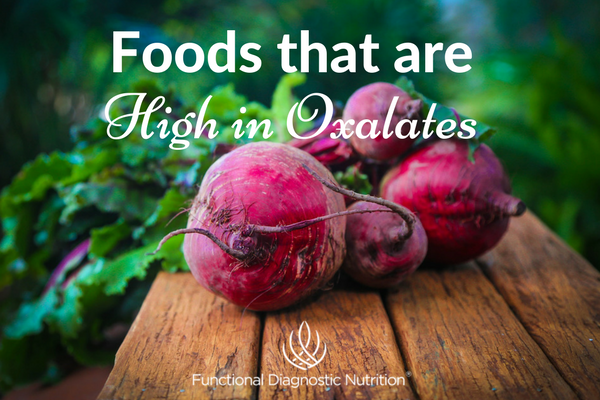Are you sensitive to oxalates? If so, you need to know about the foods that are high in them!
There is a popular proverb that says, “one man’s food is another man’s poison” and that saying is true. Although there are many that believe that all humans can eat the same diet, we are all unique individuals with unique dietary needs. And some people struggle with food allergies and intolerances that can make so-called “healthy” foods detrimental to their health.
That is true for those who struggle with food allergies, sensitivities and intolerances. For these people, foods that are touted as healthy can make them feel worse and even contribute to health symptoms and disease. One of the most recognized food intolerances is gluten. But gluten is not the only one!
One lesser known food component that many people are sensitive to is oxalates. Oxalates are a naturally occurring compound that is easily digested out of the body when the gut is healthy. But if there is gut dysfunction, particularly leaky gut, the chance of oxalates causing intolerance increases.
This occurs because excess oxalates can enter the body through the leaky intestinal tract, where they cause issues such as kidney stones, thyroid issues, fibromyalgia and an overgrowth of Candida.
Although most doctors are unaware of the impact of oxalate intolerance on health, there are tests that can help to uncover whether oxalates are a problem for you or not. A FDN health detective who has been trained in Oxalates can be a great first line of defense. One thing that they can help you with is to know which foods will work best for your body.
Foods that are high in oxalates should be avoided because they can make your symptoms worse! And unfortunately, if you have been trying to eat a healthy diet, you may have been contributing to the problem. This is because some of the most popular healthy foods are high in oxalates! And those foods will need to be avoided.
What foods are high in oxalates?
Nuts, nut flours and nut butters
For people eating a Paleo, grain free or low carb diet, nut flours and nut butters are a staple. But the most common nuts used in these diets are high in oxalates. If you consider that one cup of almond flour contains approximately 90 almonds, that is a lot of oxalates that people consume when they make baked goods using nut flours.
Chocolate
With this news, we hear a collective groan from chocolate lovers, but it is important to point out that the sweet dessert choice of many also contains one of the highest amounts of oxalates. The chocolate substitute carob is also rich in them.
Beans and lentils
Beans and lentils are a staple for many who eat grain free and vegetarian meals, but they are rich in oxalates. Studies have not been done to show if soaking or sprouting affect the level of oxalates in beans and lentils. Boiling them can reduce levels, but it can be as little as 30%.
Wheat
Although many people avoid this common grain, those who follow traditional ways of eating often choose to consume it soaked, sprouted or fermented. Studies have shown that fermentation can reduce oxalate levels in foods, so if you follow a traditional way of eating, using a fermented sourdough would be the best option to reduce oxalates.
Spinach
This leafy green has been the darling of the whole food, green smoothie world for a while now. But for those with oxalate sensitivities, drinking that daily smoothie could be doing more harm than good. Raw spinach is rich in oxalates, but studies have shown that steaming spinach can reduce levels by as much as 50% and boiling can reduce levels up to 83%.
Potatoes
All potatoes are high in oxalates. This includes the sweet potatoes that are popular with the Paleo crowd. Boiling them can reduce levels, although it will not completely remove them.
Berries
Although berries are lower in sugar than other fruits, they are higher in oxalates. This can cause problems for those who have sensitivities to oxalates.
Black tea
Tea is the most consumed beverage in the world. But black tea leaves are rich in oxalates. And the level of oxalates in a cup of tea can also vary by the length of time that tea leaves have steeped as well. Maybe you don’t enjoy a cup of tea, but do enjoy kombucha. Commercial types of kombucha are made with black tea, and will be high in oxalates.
Beets
This is the root vegetable that you either love or hate. But for those with oxalate intolerance, it is better to avoid or consume less of this vegetable.
While eating a diet lower in oxalates can be good for those who deal with oxalate sensitivities and intolerances, the best course of action is to work on gut health and fixing a leaky gut. This will allow the gut to function normally and to prevent the symptoms of oxalate sensitivity from occurring!
Do you want to become an expert in oxalates?
Do you have clients who are eating a healthy diet, yet are experiencing pain throughout their body? Or clients who are struggling with Candida yeast overgrowth, despite a grain-free/sugar-free diet and several rounds of anti-fungal herbs? What about clients who are experiencing mineral deficiencies, bone loss, inflamed joints and muscles, frequent urinary tract infections, or kidney stones? These can all be symptoms of excessive amounts of oxalates in the body.
Oxalates may be the cause. But you can become an expert on oxalates by taking FDN’s oxalates course. In this course, you will learn more about how oxalates become a problem, why gut dysfunction causes oxalate issues, when to test for oxalates, how to test for them, how to implement an oxalate lowering program, what improvements can be seen in clients on a program to lower oxalate levels and much more.
Learn more about the FDN Oxalate course here.







